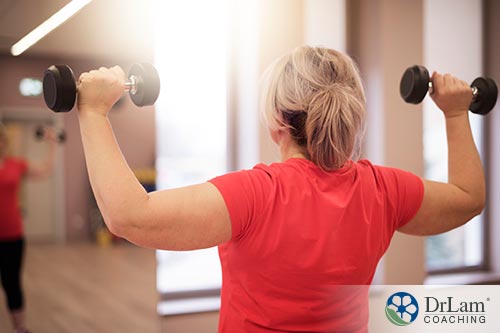Maintaining muscle mass and strength as you age is one of the keys to remaining healthy. But every adult begins losing muscle mass early. In your 40s, you have most likely attained your maximum muscle mass.
Losing muscle mass as you age is a natural process called sarcopenia. It is normal to begin losing muscle mass by 3% to 5% every decade after your 30s. Men tend to lose about 30% of their muscle mass over their lifetimes.
Losing your muscle mass may increase your risk of falls and fractures. You will likely be weaker and less mobile as well. The American Society for Bone and Mineral Research reported in 2015 that the risk of a low-trauma fall that results in a fracture increases 2.3 times if you have sarcopenia.
 Fortunately, you don’t have to live with this increased risk of fractures. While preventing sarcopenia is said to be one of the most pressing biomedical challenges of an aging society, maintaining muscle mass is a relatively easy thing to do.
Fortunately, you don’t have to live with this increased risk of fractures. While preventing sarcopenia is said to be one of the most pressing biomedical challenges of an aging society, maintaining muscle mass is a relatively easy thing to do.
Part of the reason for this condition being such a pressing issue is the large number of Baby Boomers reaching advanced ages daily. Another major part of the issue is the complexity involved in understanding the causes of the condition.
One of the widely-hyped ways to continue maintaining muscle mass is by ingesting large amounts of protein as you age. Even though there is little research evidence regarding how much protein you need as you age, this approach continues to be looked at as the number one way to prevent muscle mass loss. One study followed a large number of older men who ingested more than the recommended amount of protein for a significant amount of time. Results of this study showed these men did not increase their lean body mass, physical functioning, muscle performance, or any other of several indicators of well-being compared to those who consumed only the recommended amount of dietary protein.
A nutritionist at Northwell Health’s Huntington Hospital in Huntington, NY, saw these findings as not surprising. Even though increased protein intake is seen as almost magical by many in nutrition, it simply is not. If you intake more protein than your body can use, the protein you can’t use is either excreted in your urine or turns to fat.
There are some very serious potential risks of consuming too much protein. These risks include increased blood sugar levels, stress on your kidneys, weight gain, increased body fat, leaching of minerals from bone, and dehydration.
So, if increasing your protein intake significantly isn’t the answer to maintaining muscle mass as you age, what is?
Even though researchers are investigating a particular protein, myostatin, that interferes with muscle growth and pharmaceutical companies are developing medications to inhibit it, exercise and a good diet are the two most beneficial ways of maintaining muscle mass.
Certainly, you need protein for building muscle, but it doesn’t do it by itself. You also need resistance training. This type of training, lifting weights, is probably the best way to prevent loss of muscle mass.
Research has found up to 60% of people over the age of 65 are not active enough or have sedentary lifestyles as well as poor nutrition. This will lead to a loss of up to 50% of their muscle mass by the time they reach their 80s and 90s.
All that is required according to researchers is an increase in daily physical activities such as walking, gardening, or doing chores around the house. Slowing the loss of muscle mass in this way will not only lead to lowered risk of loss of functioning, it can also increase your metabolism since muscle is central to metabolism and it can improve how you deal with the stress of aging.
 Progressive resistance training or gradually increasing the amount of weight you lift and the number of reps you do may be the key to maintaining muscle mass as you age. Your diet is also important, and protein should be a major element in your diet. Protein is broken down into amino acids in your body. It is these amino acids your body uses to build protein.
Progressive resistance training or gradually increasing the amount of weight you lift and the number of reps you do may be the key to maintaining muscle mass as you age. Your diet is also important, and protein should be a major element in your diet. Protein is broken down into amino acids in your body. It is these amino acids your body uses to build protein.
One reason to increase the amount of protein you ingest may have to do with something called anabolic resistance, a condition that older men sometimes have that decreases their bodies’ ability to break down and utilize protein. If this is the case, then more protein intake is needed.
Just like with progressive resistance training, as you age you need more protein. A report in the journal Nutrients said 1 to 1.3 grams of protein per kilogram of weight daily is needed if you are older and are participating in resistance training. Dividing this amount of protein among your meals gives your body the best chance of utilizing it to build muscle mass.
Research has shown a decrease in the amount of testosterone in older men’s bodies to be one reason for the loss of muscle mass. Testosterone stimulates muscle growth and the synthesis of protein.
Levels of this hormone naturally begin declining in men at about the same age as loss of muscle mass. But another potential cause of loss of testosterone is an increase in cortisol levels due to stress.
 When you experience stress from any source, one of the results is an increase in cortisol produced by your adrenal glands. Cortisol is the stress-fighting hormone. With continuing stress, the amount of cortisol available decreases as your adrenals become fatigued. A condition called Adrenal Fatigue Syndrome (AFS) may begin at that point. This condition is seen in vague symptoms that can increase in severity over time.
When you experience stress from any source, one of the results is an increase in cortisol produced by your adrenal glands. Cortisol is the stress-fighting hormone. With continuing stress, the amount of cortisol available decreases as your adrenals become fatigued. A condition called Adrenal Fatigue Syndrome (AFS) may begin at that point. This condition is seen in vague symptoms that can increase in severity over time.
Because of the vagueness of these symptoms, conventionally trained health professionals usually don’t assess or deal with them adequately. A more comprehensive approach is the NeuroEndoMetabolic (NEM) Stress Response. This viewpoint says there are six health circuits in the body that are affected by and can help you deal with symptoms of AFS. These circuits inter-relate in that what affects one affects others as well. This approach helps health professionals get to the root causes of your symptoms.
In your efforts at maintaining muscle mass as you age, you must consider insulin resistance. Healthy insulin sensitivity is essential in maintaining muscle mass.
Insulin is an important factor in preventing the breakdown of muscle between meals and overnight. As you age, it isn’t as able to perform this function as when you were young.
A part of the insulin pathway called mTOR must be activated in order for your body to build muscle. This won’t happen if you are insulin resistant. This mTOR mechanism can be activated through both diet and exercise.
A peptide, GLP-1, increases healthy insulin secretion and aids insulin in working more effectively. Human growth hormone (HGH), is also important in preventing loss of muscle mass. Both of these are increased through consuming good proteins and significant exercise.
In addition to increasing your activity level and eating more good proteins, there are other things that are important in maintaining muscle mass as you age.
Increasing foods that contain leucine is one step in maintaining muscle mass. Leucine stimulates the synthesis of protein in both young and older people. The best sources of leucine are animal foods such as fish, eggs, poultry, beef, and products made with milk. To a smaller extent, it’s also found in soybeans, other beans, nuts, and seeds.
Omega-3 fatty acids have been shown to benefit muscle protein metabolism and mitochondrial physiology in older adults.
Hormone levels and balances have been shown to affect muscle mass as well. Lower levels of HGH, DHEA, and testosterone should be addressed. Using natural supplementation under a health professional’s supervision is the best way to increase the levels of these needed hormones. In women, a reduction in the levels of estradiol during menopause may lead to loss of muscle mass. Lower muscle performance has been seen with a reduction in ovarian hormones during menopause.
 More and more frequently, the presence of inflammation has been linked to loss of muscle mass. Getting away from the standard American diet and more into diets such as the Mediterranean diet is one way to decrease pro-inflammatory foods and increase anti-inflammatory foods in your diet. Overly processed foods are some of the most pro-inflammatory. These foods are also high in omega-6 fatty acids. These fatty acids are needed in your diet, but only to an extent. If you have too much of them, or if they are not balanced by omega-3 fatty acids, they can increase the risk of developing inflammation.
More and more frequently, the presence of inflammation has been linked to loss of muscle mass. Getting away from the standard American diet and more into diets such as the Mediterranean diet is one way to decrease pro-inflammatory foods and increase anti-inflammatory foods in your diet. Overly processed foods are some of the most pro-inflammatory. These foods are also high in omega-6 fatty acids. These fatty acids are needed in your diet, but only to an extent. If you have too much of them, or if they are not balanced by omega-3 fatty acids, they can increase the risk of developing inflammation.
Refined sugars and carbohydrates also increase your risk of inflammation.
Over time, drinking too much alcohol will lead to weakened muscles. Skeletal muscles are most often affected by drinking too much.
While loss of muscle mass is to be expected as you age, it is not a condition that can’t be reversed. Proper diet including protein intake and increased activity level, especially resistance training, are the tools that will help you maintain your muscle mass.
© Copyright 2019 Michael Lam, M.D. All Rights Reserved.
Maintaining muscle mass as you age requires consumption of the right kind of protein and an increase in progressive resistance training. In spite of the recommendations of many nutritionists, just increasing the amount of protein ingested is insufficient to keep muscle mass.
